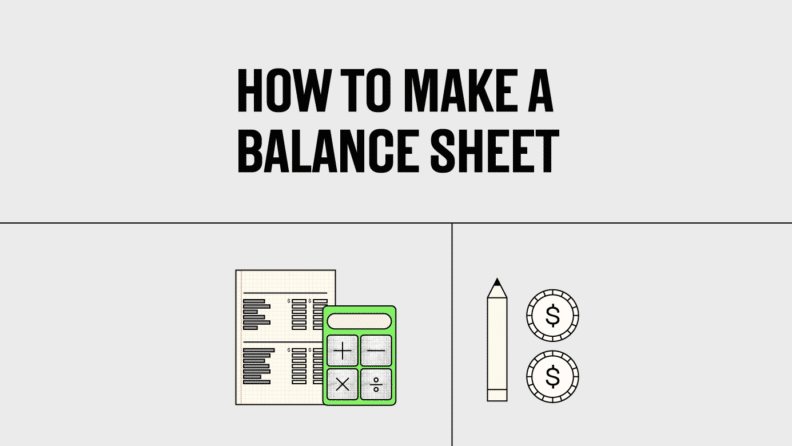Making a balance sheet involves categorizing all accounts with a debit or credit balance and presenting those categories in a predefined format. Here's how to make a balance sheet, even if you’ve never created one before.
Why Do You Need A Balance Sheet?
Before you create a balance sheet for your business, let’s talk about why you need one in the first place. Here’s a quick overview of the reasons to prepare this statement:
- Keep tabs on fiscal fitness: The balance sheet tells you what your business owns and owes, and what’s left over for equity shareholders.
- Make smarter decisions: It helps management make smarter decisions when planning expansion and raising capital.
- Give investors a peek into your business: Investors decide if they want to invest in a company based on factors like the level of debt and age/quality of assets.
Creating Your Balance Sheet
Let’s dive into the nitty-gritty of preparing your balance sheet. Before we start, remember that most companies don’t prepare the statement manually; accounting software automatically creates real-time balance sheets as the bookkeeper logs day-to-day transactions.
That said, learning to prepare it manually is a great way to truly understand how it works and where all the numbers come from.
As I explain how to make a balance sheet, I’ll use Apple’s as an example. Here’s a step-by-step guide:
1. Select a Reporting Date
Balance sheets are prepared at a specific point in time, unlike an income statement, which shows the company’s performance over a defined period. The balance sheet is a statement that shows the balances of all accounts in your books, and since account balances change with every business transaction, the balance sheet may look different after every transaction.
Corporations like Apple generally choose the end of the financial reporting period as the date of the balance sheet:
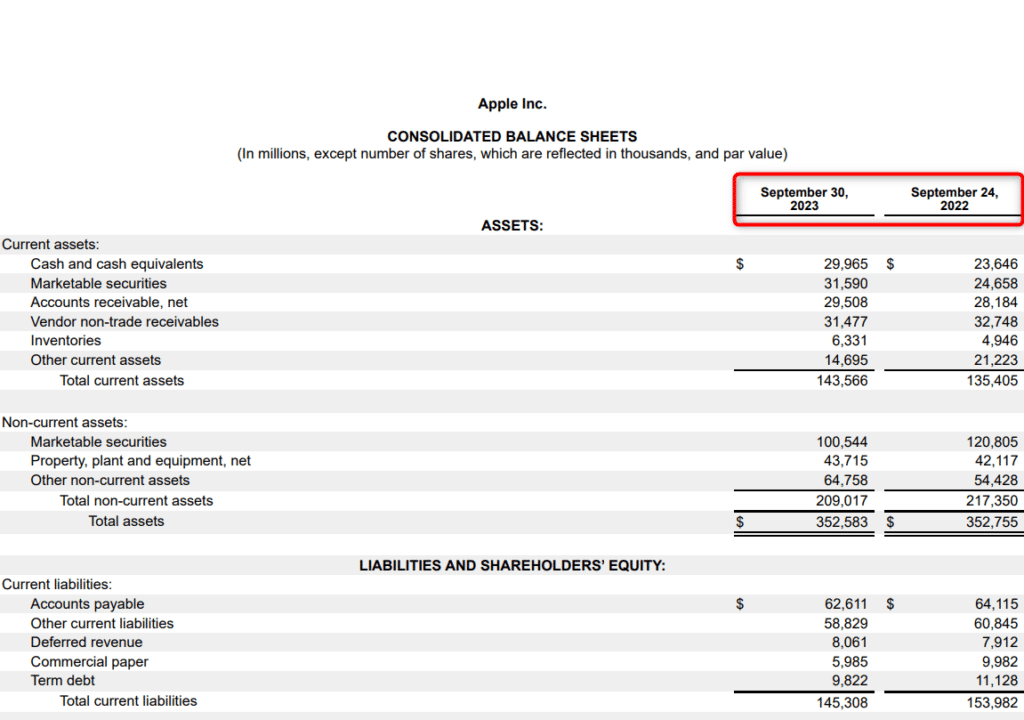
You don’t necessarily have to wait until the end of the accounting cycle to prepare a balance sheet. While most companies prepare their balance sheet when closing their books each month, quarter, or year, you can choose to prepare a balance sheet any time you want to conduct analysis.
For example, if you’re about to acquire a company, you’ll need an updated balance sheet to understand how the acquisition will impact you in the immediate term.
2. Prepare the Income Statement and Statement of Retained Earnings
When getting your financial statements in order, the balance sheet is prepared last.
Every year, your business (hopefully) makes a profit. If not distributed as dividends, profit ends up in the equity shareholders’ accounts as retained earnings. This increases the amount reported under the stockholders’ equity section of the balance sheet, which is why you need to prepare the income statement and statement of retained earnings before you start preparing your balance sheet.
If we back up even further, we find that the income statement helps calculate the net income, which helps prepare the statement of retained earnings, which then leads back here.
3. List Your Assets
Once you have all the figures you need, the first order of business is to list your company’s assets. Here’s how Apple presents assets on its balance sheet:
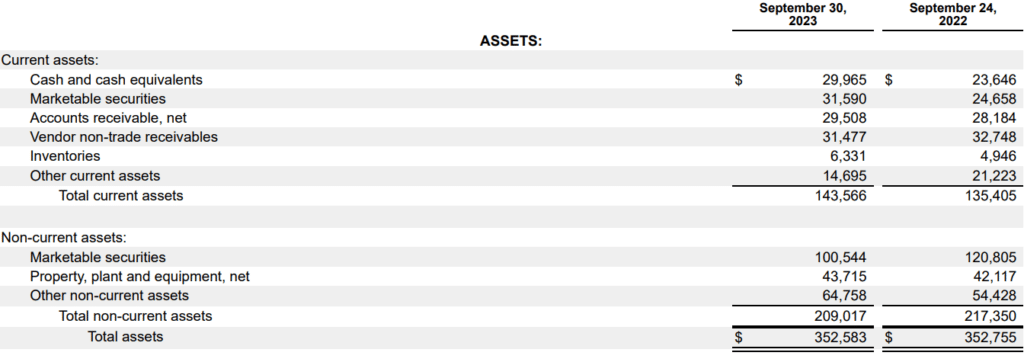
Assets are resources your company owns. They’re listed on the balance sheet in order of liquidity, with the most highly liquid assets listed first. Broadly, assets are categorized as current and non-current:
- Current assets: Current assets a company can convert into cash in the short term (within a year or one operating cycle). For example, cash, cash equivalents (marketable securities, commercial instruments, or other money market instruments), inventory, and accounts receivable.
- Non-current assets: Non-current assets are long-term assets. They’re categorized into fixed (or tangible) assets and intangible assets. Fixed assets—including land, buildings, and depreciable assets such as equipment and vehicles—are recorded at book value, net of depreciation. Intangible assets like goodwill appear at last, because they can only be converted into cash when you sell your business.
4. List Your Liabilities
After you’ve added all your assets, it’s time to add your business’s liabilities to the balance sheet. Similar to assets, liabilities are categorized as current and non-current:
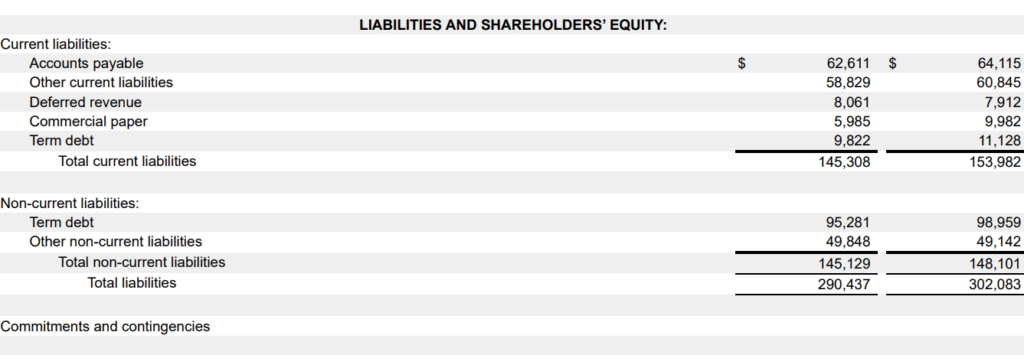
- Current liabilities: Current liabilities are debts a company must pay within one operating cycle (again, typically one year or less). Accounts payable, short-term debt, and unpaid dividends are examples of current liabilities.
- Non-current liabilities: Non-current liabilities are long-term debts (that aren’t due within the next 12 months). Long-term liabilities include bonds payable, pension benefit obligations, and deferred tax liabilities.
5. Calculate Shareholders’ Equity
Owner’s equity (or shareholders’ equity) is the difference between total assets and total liabilities:
Shareholders’ Equity = Total Assets - Total Liabilities
Another way to calculate the shareholders’ equity is by adding the balance in the retained earnings and common stock accounts.
Bigger companies like Apple may have additional line items—for example, companies may have additional items like preferred stock and accumulated comprehensive income. If you’re not in a large corporation, you don’t need to worry about these.
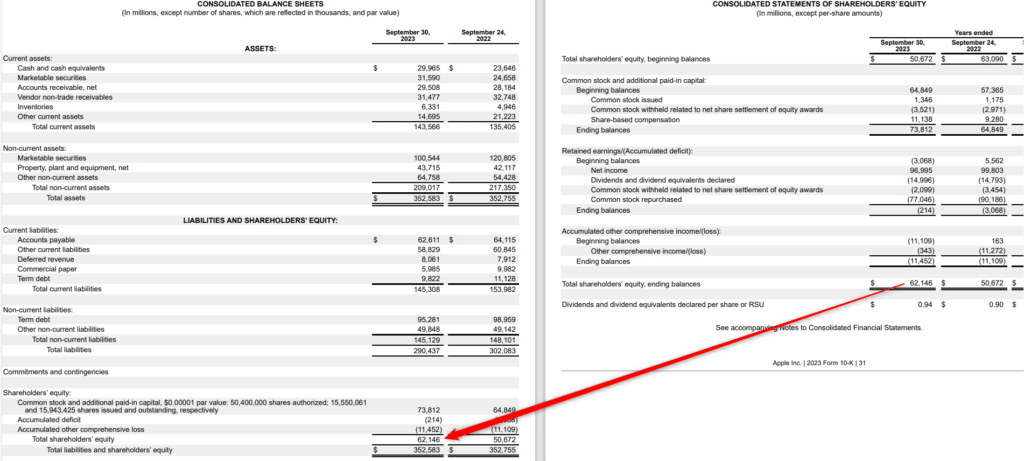
The shareholders’ equity section of the balance sheet represents the company’s theoretical net worth: It’s the amount that the business owners would be left with after selling all assets and paying liabilities. However, I say it’s theoretical because the market value of an asset is almost always different from the book value.
6. Compare Total Assets with Total Liabilities Plus Owner’s Equity
The assets must be equal to the total liabilities plus shareholders’ equity—hence the term “balance” sheet. If the figures match and everything looks good, you’re ready to rock. If it doesn’t balance, there are a few common reasons to look into:
- Omitted or inaccurately recorded transactions
- Inaccurately recorded amortization or depreciation expenses
- Errors in converting currency exchange rates
- Incorrect calculation of shareholders’ equity
How Often You Should Create A Balance Sheet
Companies typically prepare a balance sheet at the end of each accounting period. This can be monthly, quarterly, or annually. However, you don’t necessarily need to wait for the end of an accounting period to prepare a balance sheet. Small business accounting software gives you a real-time view of your balance sheet by updating it with every transaction you record.
A real-time view is helpful because it helps you assess your business’s financial health. This helps you make smarter decisions regarding various aspects of business, such as a change in credit policy or how much capital the company should raise (and when).
Balance Sheet Example & Analysis
You have a balance sheet, so what’s next?
Experienced accountants can pretty much eyeball the statement and get a sense of the company’s financial position, but you shouldn’t try to hold yourself to that standard just yet.
If you’re just preparing your first balance sheet, you can use financial metrics like the current ratio and debt-to-equity ratio to assess your company’s balance sheet.
Let’s use a simplified version as an example to understand how you can assess it:
| Assets | Amount ($) | |
| Current Assets | $100,000 | |
| Non-Current Assets | $300,000 | |
| Total | $400,000 | |
| Liabilities and Shareholder’s Equity | ||
| Current Liabilities | $50,000 | |
| Non-Current Liabilities | $250,000 | |
| Stockholders’ Equity | $100,000 | |
| Total | $400,000 | |
Here are some quick insights we can draw from this example:
- Positive working capital: The company has a positive working capital of $50,000. Working capital is calculated by subtracting current liabilities from current assets.
- Debt-to-equity (D/E) ratio: The D/E ratio tells you how much of your capital comes from debt versus equity—in the example above, the D/E ratio is 3. It’s calculated by dividing total liabilities by shareholders’ equity. There’s no single D/E ratio that’s good or bad, but you can refer to industry averages to see how you stack up.
- Current ratio: Quick ratio is a liquidity ratio that shows your company’s capacity to pay short-term obligations within a year. In our example, the current ratio is 2. It’s calculated by dividing the total of cash, cash equivalents, and marketable securities by total current liabilities.
There are three of the many balance sheet ratios you can use to analyze how a company is doing.
Make Smart Financial Decisions With Your Balance Sheet
This statement helps all stakeholders—management, investors, and lenders—make informed decisions about the business.
Management may look at the balance sheet to manage working capital or leverage. Investors may use it to analyze the asset portfolio and capital structure. Lenders may look at whether your balance sheet has some more room for debt capital without causing any financial discomfort on your balance sheet, income statement, or cash flow statement.
Want to learn more about financial statements and other financial concepts? Subscribe to our free newsletter for expert advice, tips, and insights from finance leaders.

